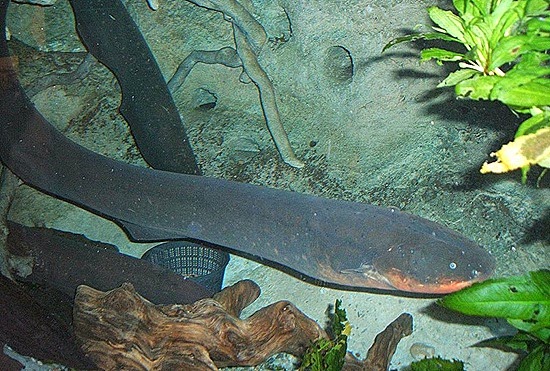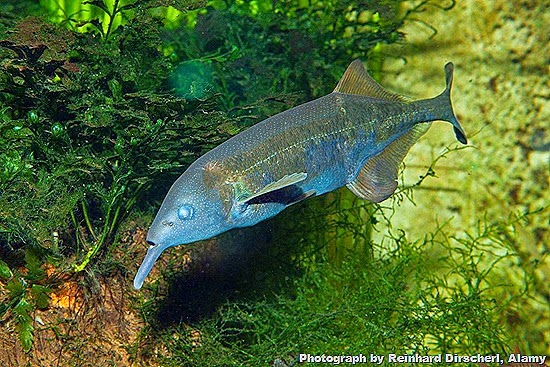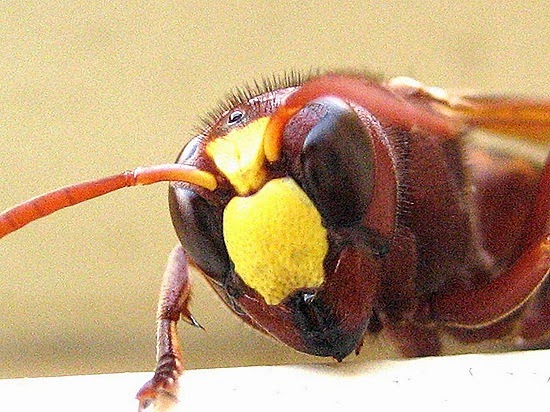
Some animals are just plain shocking in that they’ve evolved the ability to detect naturally occurring electric fields, while others can produce their own electricity.
In a study published today in the journal Science, researchers have worked out how six different groups of electric fish evolved organs capable of generating electricity. All muscle cells have electrical potential, but in these six groups of fish, certain muscle cells evolved over millions of years into cells called electrocytes, which generate much higher voltages than ordinary muscle cells do. This enabled these electric fish, all native to the muddy Amazon River, to employ their active electric sense much like bats use echolocation: to detect obstacles and other animals in the dark.
“Electric fish can electrically ‘illuminate’ their environs to detect objects that differ in their electric properties from the surrounding water,” says Gerhard von der Emde, a neuroethologist at the University of Bonn. They also produce electric signals to communicate with one another while attracting mates and marking their territory.
But fish aren’t the only electric animals on the block. Several other species detect or generate electricity for a variety of purposes.
1. Electric Eel
Credit: Steven G. Johnson/Wikimedia Commons
Despite its name and serpentine appearance, the electric eel is not an eel at all, but rather a type of electric fish. Like other electric fish, they’re nearly always producing low-voltage pulses to sense their environment. But they are more infamous for their ability to generate extremely high-voltage shocks to stun or kill prey and defend themselves.
Electric eels can grow to over eight feet (2.4 meters) long and weigh nearly 50 pounds (22.7 kilograms). An eel this size can emit a burst of over 600 volts, five times the voltage of a standard U.S. wall socket.
Human deaths from electric eel shocks are rare, but have occurred. Repeated shocks can cause respiratory and heart failure, and people have drowned after being stunned by electric eels.
2. Elephantnose Fish
An elephantnose fish swims in the Congo River.
First of all, that’s not its nose - it’s actually an elongated chin. The scientific term for this specialized organ is the Schnauzenorgan, and it’s covered in sensors attuned to detecting electric fields.
The elephantnose fish belongs to a group of electric fish native to Africa. Due to its poor eyesight, it must find food and navigate its surroundings by generating an electrical field through its tail. It then senses any changes to that field with its Schnauzenorgan.
The organ is so sensitive that the elephantnose fish can tell the difference between living and dead bugs buried up to 0.8 inches (two centimetres) in the seafloor. They can also use the Schnauzenorgan to determine distances and distinguish between materials, shapes, and sizes of objects.
Elephantnose fish also have an enormous brain relative to their body size, and von der Emde says the fish are very intelligent, easily learning new tasks and capable of understanding abstract concepts. “When ‘bored,’ they play with objects such as stones, air bubbles, or tubes that we put in their tanks,” he says.
3. Platypus
A platypus says hello.
The mystery of how platypuses catch their prey in murky water at night, with their eyes, ears, and nostrils closed, puzzled scientists for years. Then researchers discovered that, unlike any other land mammal, platypuses use the electrical impulses emitted by their prey to home in on a meal.
A platypus’ bill is covered in nearly 40,000 electricity sensors - or electroreceptors - arranged in a series of stripes, which helps them localize prey. All animals produce electric fields due to the activity of their nerves and muscles. So when the platypus digs in the bottom of streams with its bill, its electroreceptors detect these tiny currents, allowing it to tell living prey from inanimate objects.
4. Sharks
Hammerhead shark. Credit: suneko/Wikimedia Commons.
All sharks and rays can detect electric fields, thanks to the hundreds to thousands of tiny pores, filled with an electrically conductive jelly, that pepper their head.
Sharks primarily use their electric sense to find food. “Sharks can use other senses, like olfaction, to home in on prey and then do the final localization directed by their electric fields,” says David Bodznick, a biologist at Wesleyan University in Middletown, Connecticut. “It works well when prey is buried in the sand or at night-time or in murky water.”
Hammerhead sharks use their heads like giant detectors, sweeping them over the seafloor to sense the electrical impulses of buried fish. “It may be that the big, broad head of the hammerhead allows it to more accurately triangulate the position of prey,” says Stephen Kajiura, a biologist at Florida Atlantic University in Boca Raton.
Sharks’ electrosense appears to be the most sensitive in the animal kingdom, capable of detecting voltage gradients as small as one billionth of a volt. It’s so sensitive, in fact, that scientists have trouble measuring it with even the most sophisticated instruments.
5. Electric Rays
Pacific electric ray (Torpedo californica). Credit: Daniel Gotshall/Wikimedia Commons.
Some rays, in addition to being able to detect electrical fields, can produce electricity. There are 69 species of electric rays - found in all the world’s oceans - and they range in size from three feet (0.9 meters) across to about the size of a dinner plate. The voltage they produce varies with their size, with smaller rays generating less than ten volts and larger ones capable of producing up to 220 volts.
Some species, like the Pacific electric ray, use their electricity to stun prey. But not all of them employ electricity when hunting. While studying the lesser electric ray, Kajiura found that even given multiple opportunities, these rays never used their electric organ to stun their prey. “When they were threatened by a predator, that’s when they zapped, and they zapped like crazy,” he says. Rays may also use their electric sense to detect predators, find mates, and communicate with one another.
6. Oriental Hornet
Credit: Avinoam (koko) Michaely/Wikimedia Commons
The Oriental hornet is a truly solar-powered animal: Its exoskeleton is capable of transforming solar energy into electricity.
Unlike most hornets that avoid activity during the hottest part of the day, Oriental hornets are out in force when the sun is most intense. The brown-and-yellow-striped insects do this to harvest the sun’s energy.
What do Oriental hornets do with this home-grown electricity? Experts aren’t sure, but some research finds the electricity could help the insects create enzymes that aid in their metabolism. It could also help keep the hornets comfortable even at high temperatures; they can stay cool by converting heat energy into electricity, which they can then store and convert back into heat when it cools down.
Alternatively, the electricity might give their wing muscles an energy boost. Shining ultraviolet light on anesthetized hornets made them wake up faster and immediately fly away, as if it recharged their batteries.
Top image: Gymnarchus niloticus electric fish. Credit: Wiki-Harfus/Wikimedia Commons.






No comments:
Post a Comment
Please adhere to proper blog etiquette when posting your comments. This blog owner will exercise his absolution discretion in allowing or rejecting any comments that are deemed seditious, defamatory, libelous, racist, vulgar, insulting, and other remarks that exhibit similar characteristics. If you insist on using anonymous comments, please write your name or other IDs at the end of your message.